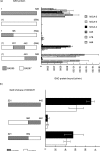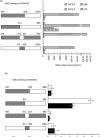Comparative analysis of epitope recognition of glutamic acid decarboxylase (GAD) by autoantibodies from different autoimmune disorders
- PMID: 10594551
- PMCID: PMC1905454
- DOI: 10.1046/j.1365-2249.1999.01030.x
Comparative analysis of epitope recognition of glutamic acid decarboxylase (GAD) by autoantibodies from different autoimmune disorders
Abstract
Autoantibodies to GAD, an important marker of the autoimmune process in type I or insulin-dependent diabetes mellitus (IDDM), are also found in non-diabetic individuals with autoimmune polyendocrine syndrome type 1 (APS1), APS2, and stiff man syndrome (SMS). Most IDDM sera contain two distinct GAD antibody specificities, one of which targets an epitope region in the middle-third of GAD65 (IDDM-E1; amino acids 221-359) and one of which targets the carboxy-third of GAD65 (IDDM-E2; amino acids 453-569). Using 11 chimeric GAD65/GAD67 proteins to maintain conformation-dependent epitopes of GAD65, we compared the humoral repertoire of IgG antibodies from an individual with APS2-like disease (b35, b78, and b96) and MoAbs from an IDDM patient (MICA-2, MICA-3, and MICA-4). Neither the APS2 IgG antibodies nor the IDDM MoAbs bind the amino-terminal third of GAD65, but instead target the carboxy-terminal two-thirds of GAD65. Amino acids 270-359 (IDDM-E1) are targeted by one APS2 IgG antibody and MICA-4, while two other APS2 IgG antibodies, MICA-2 and MICA-3, target amino acids 443-585 (IDDM-E2). Using GAD65/67 chimera that span the IDDM-E2 region, we found that MICA-2 binds amino acids 514-528 of GAD65, but two APS2 IgG antibodies require this region and amino acids 529-570. In contrast, the binding of MICA-3 requires two discontinuous amino acid segments of GAD65 (452-513 and 528-569), but not amino acids 514-528. These results indicate that there are both similarities and differences in the humoral response to GAD65 in APS2 and IDDM.
Figures



Similar articles
-
Human B cells secreting immunoglobulin G to glutamic acid decarboxylase-65 from a nondiabetic patient with multiple autoantibodies and Graves' disease: a comparison with those present in type 1 diabetes.J Clin Endocrinol Metab. 1997 Aug;82(8):2664-70. doi: 10.1210/jcem.82.8.4171. J Clin Endocrinol Metab. 1997. PMID: 9253351
-
Two distinct glutamic acid decarboxylase auto-antibody specificities in IDDM target different epitopes.Diabetes. 1995 Feb;44(2):216-20. doi: 10.2337/diab.44.2.216. Diabetes. 1995. PMID: 7532143
-
A monoclonal antibody-based characterization of autoantibodies against glutamic acid decarboxylase in adults with latent autoimmune diabetes.Autoimmunity. 1998;28(2):61-8. doi: 10.3109/08916939809003868. Autoimmunity. 1998. PMID: 9771977
-
The glutamate decarboxylase and 38KD autoantigens in type 1 diabetes: aspects of structure and epitope recognition.Autoimmunity. 1993;15 Suppl:24-6. doi: 10.3109/08916939309008857. Autoimmunity. 1993. PMID: 7692998 Review. No abstract available.
-
Autoimmunity to glutamic acid decarboxylase (GAD) in Stiff-Man syndrome and insulin-dependent diabetes mellitus.Trends Neurosci. 1991 Oct;14(10):452-7. doi: 10.1016/0166-2236(91)90044-u. Trends Neurosci. 1991. PMID: 1722364 Review.
Cited by
-
Distinct antigenic features of linear epitopes at the N-terminus and C-terminus of 65 kDa glutamic acid decarboxylase (GAD65): implications for autoantigen modification during pathogenesis.Clin Exp Immunol. 2002 Oct;130(1):131-9. doi: 10.1046/j.1365-2249.2002.01960.x. Clin Exp Immunol. 2002. PMID: 12296864 Free PMC article.
-
Reduced display of conformational epitopes in the N-terminal truncated GAD65 isoform: relevance for people with stiff person syndrome or DQ8/8-positive Type 1 diabetes mellitus.Diabet Med. 2019 Nov;36(11):1375-1383. doi: 10.1111/dme.13827. Epub 2018 Dec 28. Diabet Med. 2019. PMID: 30264481 Free PMC article.
-
Multiplicity of the antibody response to GAD65 in Type I diabetes.Clin Exp Immunol. 2004 Nov;138(2):337-41. doi: 10.1111/j.1365-2249.2004.02610.x. Clin Exp Immunol. 2004. PMID: 15498046 Free PMC article.
-
Modulation of antigen presentation by autoreactive B cell clones specific for GAD65 from a type I diabetic patient.Clin Exp Immunol. 2004 Jan;135(1):74-84. doi: 10.1111/j.1365-2249.2004.02343.x. Clin Exp Immunol. 2004. PMID: 14678267 Free PMC article.
-
Dynamic changes of GAD65 autoantibody epitope specificities in individuals at risk of developing type 1 diabetes.Diabetologia. 2005 May;48(5):922-30. doi: 10.1007/s00125-005-1719-1. Epub 2005 Apr 16. Diabetologia. 2005. PMID: 15834701
References
-
- Baekkeskov S, Aanstoot HJ, Christgau S, et al. Identification of the 64K autoantigen in insulin-dependent diabetes as the GABA-synthesizing enzyme glutamic acid decarboxylase. Nature. 1990;347:151–6. - PubMed
-
- Christie MR, Tun RY, Lo SS, et al. Antibodies to GAD and tryptic fragments of islet 64K antigen as distinct markers for development of IDDM. Studies with identical twins. Diabetes. 1992;41:782–7. - PubMed
Publication types
MeSH terms
Substances
Grants and funding
LinkOut - more resources
Full Text Sources
Other Literature Sources
Medical
Molecular Biology Databases

